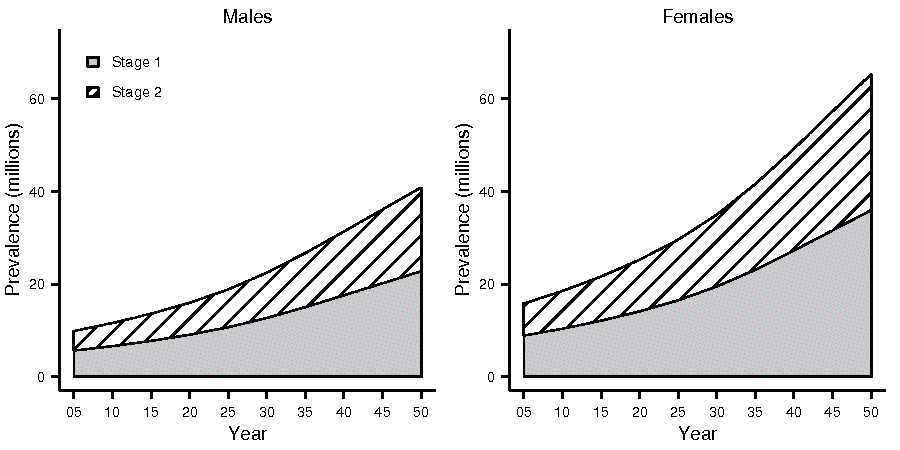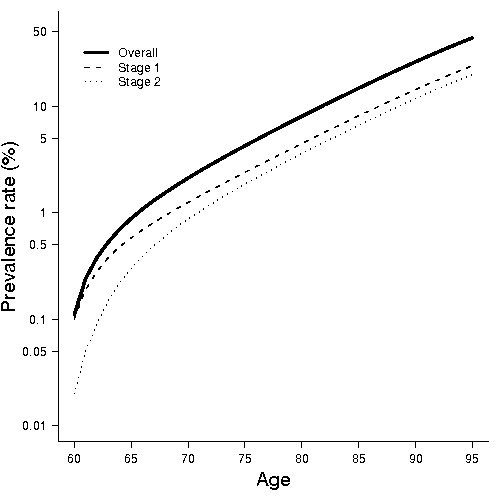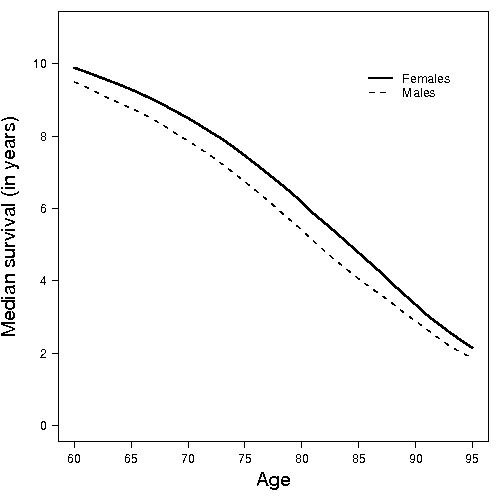Our Findings
This page summarizes the results of applying our methodology to forecast the burden of Alzheimer's disease globally and within the US.
These results can be replicated via iFBAD by using the provided population projections (global and US) and the default inputs including incidence rates, background mortality rates and model for the effect of Alzheimer's disease on mortality (i.e. additive model with no increase in background mortality during stage 1 and increase the background mortality rates by 11% during stage 2).
Global forecasts of Alzheimer's disease
We define the stages of disease based on the average number of years to transition from diagnosis of AD to care that is equivalent to full time nursing home care. We utilize an estimate of approximately 6 years on average to make the transition (reference); which translates to an annual probability of transitioning from stage 1 to 2 disease of roughly 1/6 = 0.167.
Table 1 presents the estimated prevalence of Alzheimer's disease (in millions) in 2009 and 2050. We estimate that in 2009, the global prevalence of Alzheimer's disease is approximately 29 million and that the prevalence will roughly quadruple by 2050 to 106 million. Roughly 48% of the cases of Alzheimer's disease in 2009 are in Asia; this percentage is estimated to increase to 59% by 2050 due to the projected growth of the population in Asia (relative to the other regions of the world).
| Region | Prevalence (in millions) | |||||
| 2009 | 2050 | |||||
| Overall | Early Stage | Late Stage | Overall | Early Stage | Late Stage | |
| Africa | 1.47 | 0.84 | 0.63 | 6.33 | 3.58 | 2.75 |
| Asia | 14.19 | 8.05 | 6.14 | 62.85 | 34.84 | 28.01 |
| Europe | 7.68 | 4.30 | 3.39 | 16.51 | 9.04 | 7.47 |
| Latin Am. / Caribbean | 2.30 | 1.29 | 1.00 | 10.85 | 5.99 | 4.86 |
| North America | 3.30 | 1.84 | 1.46 | 8.86 | 4.84 | 4.01 |
| Oceania | 0.25 | 0.14 | 0.11 | 0.84 | 0.46 | 0.38 |
| Total | 29.20 | 16.47 | 12.73 | 106.23 | 58.75 | 47.48 |
Figure 1 displays the estimated global prevalence of Alzheimer's disease stratified by gender and stage of disease. We estimate that roughly 44% of the cases of Alzheimer's disease are in the late stage of disease and roughly 62% of the cases are female.
Figure 1: PROJECTIONS OF ALZHEIMER’S DISEASE PREVALENCE IN MILLIONS FOR YEARS 2006 TO 2050 BY GENDER AND STAGE OF DISEASE

Interventions were introduced in 2015 that would delay disease onset and/or progression (Table 2). We considered 6 scenarios: delay the onset of disease on average by 1 or 2 years, delay the progression of disease on average by 1 or 2 years and delay both the onset and progression of disease by 1 or 2 years. Significant reductions in the global prevalence of Alzheimer's disease can be achieved with a modest delay of disease progression; introducing an intervention that would delay the progression of disease on average by 1 year in 2015 would reduce the estimated prevalence of stage 2 disease by roughly 4 million (8%) in 2050. We are assuming total coverage of the intervention; i.e. all persons with stage 1 disease would receive the intervention and it would be 100% effective.
| Mean delay (in years) | Change in global prevalence (in millions) | |||
| onset | progression | overall | early stage | late stage |
| 1 | 0 | -11.76 | - 6.32 | - 5.44 |
| 2 | 0 | -22.76 | -12.28 | -10.48 |
| 0 | 1 | + 2.84 | + 6.54 | - 3.70 |
| 0 | 2 | + 5.23 | +12.14 | - 6.91 |
| 1 | 1 | - 9.19 | - 0.48 | - 8.71 |
| 2 | 2 | -18.48 | - 2.66 | -15.82 |
Figure 2 displays the estimated prevlance rate of Alzheimer's disease in 2009 by stage for males (results similar for females). Figure 3 displays the estimated median survival in years among males and females diagnosed with Alzheimer's disease in 2009.
|
Figure 2: ESTIMATED PREVALENCE RATE (PER 100 PERSONS) OF ALZHEIMER’S DISEASE IN 2009 FOR MALES BY STAGE |
Figure 3: ESTIMATED MEDIAN SURVIVAL (IN YEARS) AMONG MALES AND FEMALES DIAGNOSED WITH ALZHEIMER’S DISEASE IN 2009. |

|

|
U.S. forecasts of Alzheimer's disease
We define stage 1 disease to be early stage disease and stage 2 to be late stage disease where persons with late stage disease require care equivalent to full time nursing home care.
Table 3 presents the estimated prevalence of Alzheimer's disease (in 10,000s) for selected years by gender and stage of disease. We estimate that currently there are roughly 2.9 million cases of Alzheimer's disease in the US and that the number of cases will roughly triple by 2050 to 8.8 million. We estimate that roughly 44% of the cases of Alzhiemer's disease are in the late stage of disease and roughly 62% of the cases are female.
| Year | Prevalence (in 10,000s) | |||||
| Males | Females | |||||
| Overall | Early Stage | Late Stage | Overall | Early Stage | Late Stage | |
| 2009 | 106 | 60 | 46 | 184 | 102 | 82 |
| 2020 | 142 | 80 | 62 | 233 | 129 | 104 |
| 2030 | 200 | 112 | 88 | 310 | 171 | 139 |
| 2040 | 277 | 153 | 124 | 425 | 232 | 193 |
| 2050 | 345 | 189 | 156 | 532 | 289 | 243 |
Interventions were introduced in 2015 that would delay disease onset and/or progression (Table 4). We considered 6 scenarios: delay the onset of disease on average by 1 or 2 years, delay the progression of disease on average by 1 or 2 years and delay both the onset and progression of disease by 1 or 2 years. Significant reductions in the US prevalence of Alzheimer's disease can be achieved with a modest delay of disease progression; introducing an intervention that would delay the progression of disease on average by 1 year in 2015 would reduce the estimated prevalence of stage 2 disease by roughly 600,000 in 2050. We are assuming total coverage of the intervention; i.e. all persons with stage 1 disease would receive the intervention and it would be 100% effective.
| Mean delay (in years) | Change in global prevalence (in 10,000s) | |||
| onset | progression | overall | early stage | late stage |
| 1 | 0 | - 92 | - 48 | - 44 |
| 2 | 0 | -180 | -94 | -86 |
| 0 | 1 | + 24 | + 55 | - 31 |
| 0 | 2 | + 44 | +101 | - 57 |
| 1 | 1 | - 70 | + 1 | - 71 |
| 2 | 2 | -143 | - 13 | -130 |
The estimated prevalence rate by stage of disease and the estimated median survival by gender are presented in the prior section.